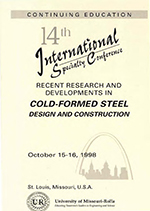Session Dates
15 Oct 1998
Abstract
The calculation of profiled sheeting and members by using the post-critical stage in which a plastic hinge is originated at the internal support is possible provided that the relationships between the support moment, reaction and hinge rotation are known. There are two alternative procedures of testing for obtaining these data: double-span test or internal support test. In the second one, instead of a global behaviour, only the local relationships between the three above characteristics are determined. When calculating with the model proposed in Eurocode 3, Part 1.3, the above two different test procedures do not lead to close enough results. The present paper is aimed at both explaining the reasons of these differences and proposing consequently an improved approach to the behaviour at the internal support.
Department(s)
Civil, Architectural and Environmental Engineering
Research Center/Lab(s)
Wei-Wen Yu Center for Cold-Formed Steel Structures
Meeting Name
14th International Specialty Conference on Cold-Formed Steel Structures
Publisher
University of Missouri--Rolla
Document Version
Final Version
Rights
© 1998 University of Missouri--Rolla, All rights reserved.
Document Type
Article - Conference proceedings
File Type
text
Language
English
Recommended Citation
Sokol, Leopold K., "A Non Linear Design Model for Continuous Multi-span Light Gauge Sheeting and Members" (1998). CCFSS Proceedings of International Specialty Conference on Cold-Formed Steel Structures (1971 - 2018). 1.
https://scholarsmine.mst.edu/isccss/14iccfsss/14iccfsss-session2/1
A Non Linear Design Model for Continuous Multi-span Light Gauge Sheeting and Members
The calculation of profiled sheeting and members by using the post-critical stage in which a plastic hinge is originated at the internal support is possible provided that the relationships between the support moment, reaction and hinge rotation are known. There are two alternative procedures of testing for obtaining these data: double-span test or internal support test. In the second one, instead of a global behaviour, only the local relationships between the three above characteristics are determined. When calculating with the model proposed in Eurocode 3, Part 1.3, the above two different test procedures do not lead to close enough results. The present paper is aimed at both explaining the reasons of these differences and proposing consequently an improved approach to the behaviour at the internal support.



